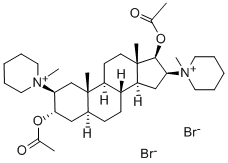판쿠로늄 브롬화물 C화학적 특성, 용도, 생산
개요
Pancuronium bromide, a bisquaternary amine and the first steroid N MBA used clinically, was developed by Savege and Hewitt and marketed in 1964. The intubating dose is 0.1mgkg–1, which takes 3-4min to reach its maximum effect. The clinical duration of action of the drug is long, especially in the presence of potent inhalational agents or renal dysfunction, as 60% of a dose of the drug is excreted unchanged through the kidneys. I t is also deacetylated in the liver; some of the metabolites have neuromuscular blocking properties.
Pancuronium does not stimulate histamine release; however, it has direct vagolytic and sympathomimetic effects which may cause tachycardia and hypertension. It slightly inhibits plasma cholinesterase and therefore potentiates any drug metabolised by this enzyme, such as suxamethonium and mivacurium.
화학적 성질
Light Beige Solid
용도
Pancuronium Bromide has been used as an analgesic in various experiments.
정의
ChEBI: A bromide salt consisting of two bromide ions and one pancuronium dication.
Biological Functions
Pancuronium bromide (Pavulon) is a synthetic bisquaternary
agent containing a steroid nucleus (amino
steroid), as denoted by the -curonium suffix. It is five
times as potent as d-tubocurarine. Unlike d-tubocurarine,
it does not release histamine or block ganglionic
transmission. Like d-tubocurarine, it has a moderately
long onset (2.9 minutes) and duration of action (110
minutes). Pancuronium and its metabolite are eliminated
in the urine.
생물학적 활성
Nicotine (neuromuscular) antagonist. Skeletal muscle relaxant.
Mechanism of action
Pancuronium bromide is a long-acting bisquaternary aminosteroid, non-depolarising neuromuscular blocking drug (NMBD). It competitively inhibits nicotinic acetylcholine receptors at the neuromuscular junction by blocking acetylcholine binding. Like other non-depolarising NMBDs, Pancuronium bromide is a competitive inhibitor of nicotinic acetylcholine (ACh) receptor post-function; under normal conditions, nicotinic acetylcholine receptor post-function in skeletal muscle is a ligand-gated ion channel, which binds to ACh and allows the passage of sodium ions, thereby inducing a depolarisation of the cell membrane leading to skeletal muscle contraction. The nicotinic ACh receptor has five subunits, and the α-subunit is the binding site for ACh and NMBD.Pancuronium bromide contains an acetylcholine-like molecule that facilitates binding to the α-subunit. Binding of pancuronium to at least one of the alpha subunits results in a conformational change in the ACh receptor, which keeps the ion channel closed, preventing ion passage and depolarisation. In addition, pancuronium bromide is a larger molecule compared to acetylcholine and may therefore physically block ion channels, preventing ion passage; this acetylcholine receptor blocking mechanism becomes more important as the number of molecules increases. In addition, it has a slight vagal function, resulting in increased heart rate but no ganglionic paralysing (i.e., ganglion-blocking) activity.
Pharmacology
Pancuronium bromide, a bisquaternary amine and the first steroid NMBA
used clinically, was developed by Savege and Hewi and marketed in 1964.
The intubating dose is 0.1 mg kg–1, which takes 3–4min to reach its maximum
effect. The clinical duration of action of the drug is long,
especially in the presence of potent inhalational agents or renal dysfunction,
as 60% of a dose of the drug is excreted unchanged through the kidneys. I t is
also deacetylated in the liver; some of the metabolites have neuromuscular
blocking properties.
Pancuronium does not stimulate histamine release; however, it has direct
vagolytic and sympathomimetic effects which may cause tachycardia and
hypertension. It slightly inhibits plasma cholinesterase and therefore
potentiates any drug metabolised by this enzyme, such as suxamethonium
and mivacurium.
Clinical Use
As indicated, the principal use of pancuronium bromideis as an adjunct to anesthesia, to induce relaxation of skeletalmuscle, but it is also used to facilitate the managementof patients undergoing mechanical ventilation. Only experiencedclinicians equipped with facilities for applyingartificial respiration should administer it, and the dosageshould be adjusted and controlled carefully.
Safety Profile
A deadly poison by ingestion, subcutaneous, intravenous, and intraperitoneal routes. Experimental reproductive effects. When heated to decomposition it emits toxic fumes of NOx and Brí.
Purification Methods
The bromide forms odourless crystals with a bitter taste which are purified through acid-washed Al2O3 and eluted with isoPrOH/EtOAc (3:1) to remove impurities (e.g. the monomethobromide) and eluted with isoPrOH to give the pure dibromide which is recrystallised from CH2Cl2/Me2CO or isoPrOH/Me2CO. It is soluble in H2O (10%) and CHCl3 (3.3%) at 20o. It is a non-depolarising muscle relaxant. [Buckett et al. J Med Chem 16 1116 1973.]
판쿠로늄 브롬화물 준비 용품 및 원자재
원자재
준비 용품







